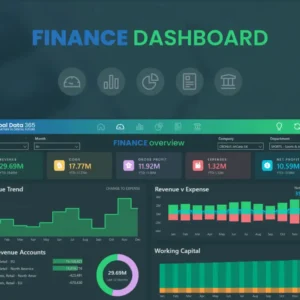Multi-Entity Consolidation Dashboard: Group Reporting Made Simple
Transform Complex Group Reporting with Power BI Consolidation Dashboards
Managing financial data across multiple entities, subsidiaries, and business units has never been more challenging. Organizations operating in today's complex business environment require sophisticated tools to consolidate, analyze, and report on group-wide financial performance. A Power BI consolidation dashboard provides the perfect solution for streamlining multi-entity reporting processes while maintaining accuracy, transparency, and compliance standards.
The traditional approach to consolidation reporting often involves manual data collection, spreadsheet manipulation, and time-intensive reconciliation processes. These methods are not only error-prone but also consume valuable resources that could be better utilized for strategic analysis. Modern organizations need automated, real-time consolidation capabilities that can handle complex organizational structures, multiple currencies, and varying accounting standards across different jurisdictions.
Power BI's advanced data modeling capabilities, combined with its intuitive visualization tools, make it an ideal platform for creating comprehensive consolidation dashboards. These dashboards can integrate data from various source systems, apply consolidation rules automatically, and present consolidated results in meaningful, actionable formats that support decision-making at all organizational levels.
Ready to Transform Your Group Reporting?
Get expert guidance on building your Power BI consolidation dashboard. Our specialists are ready to help you streamline your multi-entity reporting process.
Understanding Multi-Entity Consolidation Challenges
Organizations with multiple entities face numerous challenges when attempting to consolidate financial information. These challenges become increasingly complex as organizations grow, acquire new businesses, or expand into new markets. Understanding these challenges is crucial for designing effective consolidation solutions.
Common Consolidation Pain Points
Data Integration Complexity
Multiple source systems with different data formats, chart of accounts structures, and reporting calendars create significant integration challenges that require sophisticated mapping and transformation capabilities.
Currency Translation Issues
Foreign subsidiaries operating in different currencies require accurate translation using appropriate exchange rates, historical rates for equity accounts, and average rates for income statement items.
Intercompany Eliminations
Transactions between group entities must be identified, matched, and eliminated to prevent double-counting in consolidated results, requiring sophisticated reconciliation processes.
Regulatory Compliance
Different jurisdictions have varying reporting requirements, consolidation standards, and disclosure obligations that must be accommodated in the consolidation process.
Traditional vs. Modern Consolidation Approaches
| Aspect | Traditional Approach | Power BI Consolidation Dashboard |
|---|---|---|
| Data Collection | Manual spreadsheet gathering | Automated data integration |
| Processing Time | Weeks to complete | Real-time or daily updates |
| Error Risk | High due to manual processes | Minimized through automation |
| Audit Trail | Limited documentation | Complete data lineage tracking |
| Scalability | Difficult to scale | Easily handles growth |
| Analysis Capabilities | Basic reporting only | Advanced analytics and insights |
Power BI Consolidation Dashboard Architecture
Creating an effective Power BI consolidation dashboard requires careful consideration of data architecture, modeling approaches, and visualization strategies. The architecture must support complex consolidation requirements while maintaining performance and user experience standards.
Data Architecture Components
Data Sources
ERP systems, accounting platforms, and subsidiary databases
Data Integration
ETL processes for data extraction and transformation
Data Model
Consolidated data warehouse with standardized structures
Analytics Layer
Power BI datasets with consolidation logic
Visualization
Interactive dashboards and reports
Key Data Modeling Considerations
Successful consolidation dashboards require sophisticated data modeling that can handle the complexities of multi-entity reporting. The data model must support various consolidation scenarios while maintaining flexibility for future requirements.
Entity Hierarchy Management
Implementing a robust entity hierarchy structure is crucial for consolidation accuracy. The hierarchy should support various ownership structures, including partial ownership, joint ventures, and complex holding company arrangements. This structure enables proper proportional consolidation and equity accounting adjustments.
Period and Calendar Alignment
Managing different fiscal year-ends and reporting periods across entities requires sophisticated period mapping capabilities. The data model should accommodate various calendar structures while enabling consolidated reporting on a consistent basis.
Essential Features of Consolidation Dashboards
A comprehensive Power BI consolidation dashboard must incorporate specific features that address the unique requirements of group reporting. These features ensure accuracy, compliance, and usability across different user groups within the organization.
Reduction in Manual Processing Time
Faster Monthly Closing Process
Improved Data Accuracy
Core Dashboard Components
Executive Summary View
The executive summary provides high-level consolidated results including revenue, profitability, and key performance indicators across all entities. This view should enable quick identification of trends, variances, and areas requiring attention from senior management.
Entity Performance Analysis
Detailed entity-level reporting allows management to analyze performance across different business units, subsidiaries, or geographic regions. This analysis should support drill-down capabilities from consolidated totals to entity-specific details.
Intercompany Transaction Monitoring
Real-time monitoring of intercompany balances and transactions helps ensure proper elimination entries and identifies potential reconciliation issues before they impact the consolidation process.
Currency Translation Dashboard
Comprehensive currency translation reporting shows the impact of foreign exchange movements on consolidated results, including translation gains and losses, and sensitivity analysis for major currency exposures.
Need Expert Help with Your Consolidation Dashboard?
Our Power BI specialists can help you design and implement a comprehensive consolidation dashboard tailored to your organization's specific requirements.
Implementation Best Practices
Implementing a successful Power BI consolidation dashboard requires adherence to proven best practices that ensure scalability, maintainability, and user adoption. These practices have been developed through extensive experience with complex consolidation projects across various industries.
Data Integration Strategy
Establishing a robust data integration strategy is fundamental to consolidation success. This strategy should address data quality, frequency of updates, error handling, and data lineage tracking. Consider implementing automated data validation checks to identify and resolve data issues before they impact the consolidation process.
| Integration Aspect | Best Practice | Benefits |
|---|---|---|
| Data Validation | Implement automated checks at source | Early issue identification and resolution |
| Error Handling | Build comprehensive exception reporting | Improved data quality and reliability |
| Update Frequency | Balance timeliness with system performance | Optimal resource utilization |
| Data Lineage | Track data from source to report | Enhanced auditability and troubleshooting |
Performance Optimization Techniques
Large consolidation datasets can impact dashboard performance if not properly optimized. Implementing appropriate data compression, aggregation strategies, and query optimization techniques ensures responsive user experience even with complex consolidation calculations.
Data Model Optimization
Optimize your data model by implementing star schema designs, appropriate data types, and calculated columns versus measures where applicable. Consider implementing aggregation tables for frequently accessed summary information to improve query performance.
Incremental Refresh Strategy
Implement incremental refresh for large historical datasets to balance data freshness with refresh performance. This approach is particularly important for consolidation dashboards that need to maintain several years of historical data for trend analysis and comparative reporting.
Advanced Consolidation Techniques
Modern consolidation dashboards must support sophisticated accounting treatments and complex organizational structures. Advanced techniques enable organizations to handle challenging consolidation scenarios while maintaining accuracy and compliance.
Complex Ownership Structures
Handling complex ownership structures requires sophisticated calculations for proportional consolidation, equity method accounting, and non-controlling interest calculations. The dashboard should automatically apply appropriate consolidation percentages and generate necessary adjustment entries.
Step Acquisition Modeling
Organizations that acquire entities in multiple steps need specialized handling for step acquisitions, including fair value adjustments, goodwill calculations, and gain or loss recognition on previously held interests.
Joint Venture Accounting
Joint ventures require proportional consolidation or equity method treatment depending on the level of control and applicable accounting standards. The dashboard should support both treatments and enable easy switching between methods when circumstances change.
Multi-GAAP Reporting
Organizations reporting under multiple accounting standards (IFRS, US GAAP, local GAAP) need dashboards that can maintain parallel consolidation processes. This capability enables consistent group reporting while satisfying various regulatory requirements.
Consolidation Process Flow
Automation and Workflow Management
Automating consolidation processes reduces manual effort, minimizes errors, and enables more frequent reporting cycles. Modern Power BI consolidation dashboards should incorporate workflow management capabilities that guide users through the consolidation process while maintaining control and audit trails.
Automated Data Refresh Strategies
Implementing intelligent data refresh strategies ensures that consolidated information is current while optimizing system resources. Consider time-based refresh schedules, event-driven updates, and conditional refresh logic based on data availability and quality checks.
Exception Management Workflows
Comprehensive exception management identifies, tracks, and resolves consolidation issues systematically. The dashboard should provide automated alerts for significant variances, missing data, or failed validations, along with workflow tools for issue resolution and approval processes.
Approval Workflow Integration
Integrate approval workflows that route consolidation packages through appropriate review and sign-off processes. This integration ensures proper internal controls while maintaining an audit trail of all consolidation activities and approvals.
Security and Access Control
Consolidation dashboards contain sensitive financial information that requires robust security measures. Implementing appropriate access controls, data protection, and audit logging ensures that confidential information remains secure while enabling authorized users to access the information they need for their roles.
Role-Based Access Control
Implement granular role-based access control that restricts access based on user responsibilities, geographic locations, or business units. Consider implementing dynamic security that automatically adjusts access based on organizational hierarchy or project assignments.
| User Role | Access Level | Key Permissions |
|---|---|---|
| Executive Management | Full Consolidated View | All entities, all metrics, trend analysis |
| Finance Team | Detailed Analysis | Entity details, intercompany, adjustments |
| Entity Controllers | Entity-Specific | Own entity data, intercompany matches |
| External Auditors | Read-Only Access | Historical data, audit trails, documentation |
Data Protection and Compliance
Ensure compliance with data protection regulations such as GDPR, SOX, and industry-specific requirements. Implement data classification, encryption, and retention policies that protect sensitive financial information while enabling necessary business processes.
Monitoring and Performance Analytics
Continuous monitoring of dashboard performance, user adoption, and data quality ensures that the consolidation solution continues to meet organizational needs. Implementing comprehensive monitoring strategies enables proactive identification of issues and optimization opportunities.
Key Performance Indicators for Consolidation Dashboards
Data Quality Metrics
Monitor data completeness, accuracy, and timeliness across all source systems. Track validation failures, data reconciliation issues, and source system availability to ensure consolidation reliability.
Process Efficiency Indicators
Measure consolidation cycle time, manual intervention requirements, and automation success rates. These metrics help identify bottlenecks and optimization opportunities in the consolidation process.
User Adoption Analytics
Track dashboard usage patterns, user engagement levels, and feature utilization rates. Understanding user behavior helps optimize dashboard design and training requirements.
System Performance Metrics
Monitor query response times, refresh durations, and system resource utilization. Performance metrics ensure optimal user experience and identify capacity planning needs.
Continuous Improvement Framework
Establish a continuous improvement framework that regularly evaluates dashboard effectiveness, user feedback, and changing business requirements. This framework should include scheduled reviews, user surveys, and performance assessments to guide ongoing enhancements.
Feedback Collection Mechanisms
Implement systematic feedback collection through user surveys, focus groups, and usage analytics. Regular feedback ensures that the dashboard continues to meet evolving user needs and identifies opportunities for enhancement.
Integration with Enterprise Systems
Modern consolidation dashboards must integrate seamlessly with existing enterprise systems to provide comprehensive financial management capabilities. This integration extends beyond simple data connectivity to include workflow integration, master data synchronization, and cross-system analytics.
ERP System Integration
Deep integration with enterprise resource planning systems enables real-time data flow and eliminates manual data transfer processes. Consider implementing APIs, web services, or direct database connections that maintain data integrity while supporting near real-time consolidation updates.
Financial Planning and Analysis Integration
Integrating consolidation dashboards with financial planning and analysis (FP&A) systems creates a comprehensive financial management ecosystem. This integration enables seamless comparison between actual consolidated results and budgets or forecasts across all entities.
Mobile and Responsive Design Considerations
Executive users and remote teams require access to consolidation information from mobile devices and various screen sizes. Implementing responsive design principles ensures optimal user experience across all platforms while maintaining functionality and readability.
Mobile Dashboard Optimization
Mobile-optimized dashboards should prioritize the most critical consolidation metrics while providing drill-down capabilities for detailed analysis. Consider implementing progressive disclosure techniques that reveal additional detail as users navigate deeper into the data.
Touch-Friendly Interface Design
Design interfaces that accommodate touch interactions, including appropriate button sizes, gesture support, and simplified navigation. Mobile users should be able to access key consolidation information quickly without complex manipulation requirements.
Disaster Recovery and Business Continuity
Consolidation processes are critical business functions that require robust disaster recovery and business continuity planning. Implementing appropriate backup strategies, failover capabilities, and recovery procedures ensures that consolidation activities can continue even during system disruptions.
Backup and Recovery Strategies
Develop comprehensive backup strategies that protect both data and dashboard configurations. Consider implementing automated backup processes, regular recovery testing, and documented recovery procedures that enable rapid restoration of consolidation capabilities.
| Recovery Component | Backup Frequency | Recovery Time Objective |
|---|---|---|
| Transaction Data | Real-time/Hourly | < 2 hours |
| Dashboard Configurations | Daily | < 4 hours |
| Historical Archives | Weekly | < 24 hours |
| System Documentation | Monthly | < 48 hours |
Training and Change Management
Successful implementation of Power BI consolidation dashboards requires comprehensive training programs and effective change management strategies. Users must understand not only how to use the new tools but also how the new processes improve their work efficiency and decision-making capabilities.
User Training Program Development
Develop role-specific training programs that address the unique needs of different user groups. Executive users need training focused on interpretation and analysis, while finance team members require detailed instruction on dashboard maintenance and troubleshooting procedures.
Training Delivery Methods
Implement multiple training delivery methods including live sessions, recorded tutorials, documentation, and hands-on workshops. Consider creating a training portal with searchable content, video tutorials, and interactive guides that users can access when needed.
Change Management Best Practices
Effective change management ensures smooth transition from legacy consolidation processes to the new Power BI dashboard environment. Communicate benefits clearly, address user concerns proactively, and provide adequate support during the transition period.
Future-Proofing Your Consolidation Dashboard
Technology and business requirements continue to evolve, making it essential to design consolidation dashboards that can adapt to future needs. Consider emerging trends such as artificial intelligence, machine learning, and advanced analytics when planning your dashboard architecture.
Artificial Intelligence Integration
Explore opportunities to integrate AI capabilities such as anomaly detection, predictive analytics, and automated variance analysis. These capabilities can enhance the value of consolidation dashboards by providing proactive insights and reducing manual analysis requirements.
Machine Learning Applications
Machine learning algorithms can improve consolidation accuracy by learning from historical patterns, identifying potential errors, and suggesting corrections. Consider implementing ML models for currency rate prediction, seasonal adjustment calculations, and fraud detection in intercompany transactions.
Cloud-Native Architecture Benefits
Leveraging cloud-native architectures provides scalability, flexibility, and cost optimization benefits. Cloud platforms offer advanced analytics services, global accessibility, and automatic scaling capabilities that traditional on-premises solutions cannot match.
Cost Reduction with Cloud Migration
Faster Deployment Times
Cloud Platform Availability
Conclusion
Power BI consolidation dashboards represent a transformative approach to multi-entity group reporting that addresses the challenges of modern organizational complexity. By implementing the strategies, best practices, and advanced techniques outlined in this guide, organizations can achieve significant improvements in consolidation efficiency, accuracy, and insight generation.
The journey toward automated consolidation requires careful planning, stakeholder engagement, and ongoing optimization. However, the benefits of reduced manual effort, improved accuracy, and enhanced analytical capabilities justify the investment and effort required for successful implementation.
Organizations that embrace modern consolidation dashboard technologies position themselves for sustainable growth, improved financial transparency, and enhanced decision-making capabilities. The combination of Power BI's powerful analytics engine with proper implementation methodology creates consolidation solutions that scale with organizational growth while maintaining the flexibility to adapt to changing business requirements.
Success in consolidation dashboard implementation depends on understanding both the technical capabilities of Power BI and the specific business requirements of your organization. By following the comprehensive guidance provided in this resource, finance teams can build consolidation solutions that deliver lasting value and competitive advantage.
Transform Your Consolidation Process Today
Ready to revolutionize your multi-entity reporting with a Power BI consolidation dashboard? Our experienced team is here to guide you through every step of the implementation process.
Related Resources from PowerBIGate
Essential Financial KPIs Every Power BI Dashboard Should Track
Discover the most important financial KPIs and learn how to effectively track them in your Power BI dashboards for better financial performance monitoring.
Power BI for SaaS Companies: Advanced Analytics Guide
Comprehensive guide to implementing Power BI analytics for SaaS businesses, including subscription metrics, churn analysis, and revenue optimization strategies.
Power BI Metadata Management: Best Practices and Tools
Learn advanced metadata management techniques for Power BI environments to improve data governance, lineage tracking, and dashboard maintenance.
Power BI vs Excel for Financial Reporting: Complete Comparison
Detailed comparison between Power BI and Excel for financial reporting, helping you choose the right tool for your organization's reporting needs.
How to Build a CFO Executive Dashboard in Power BI (Free Template)
Step-by-step guide to creating executive-level financial dashboards with our free CFO dashboard template and implementation best practices.
PowerBIGate Homepage
Visit our homepage to explore all our Power BI resources, templates, and professional services for business intelligence and analytics solutions.







